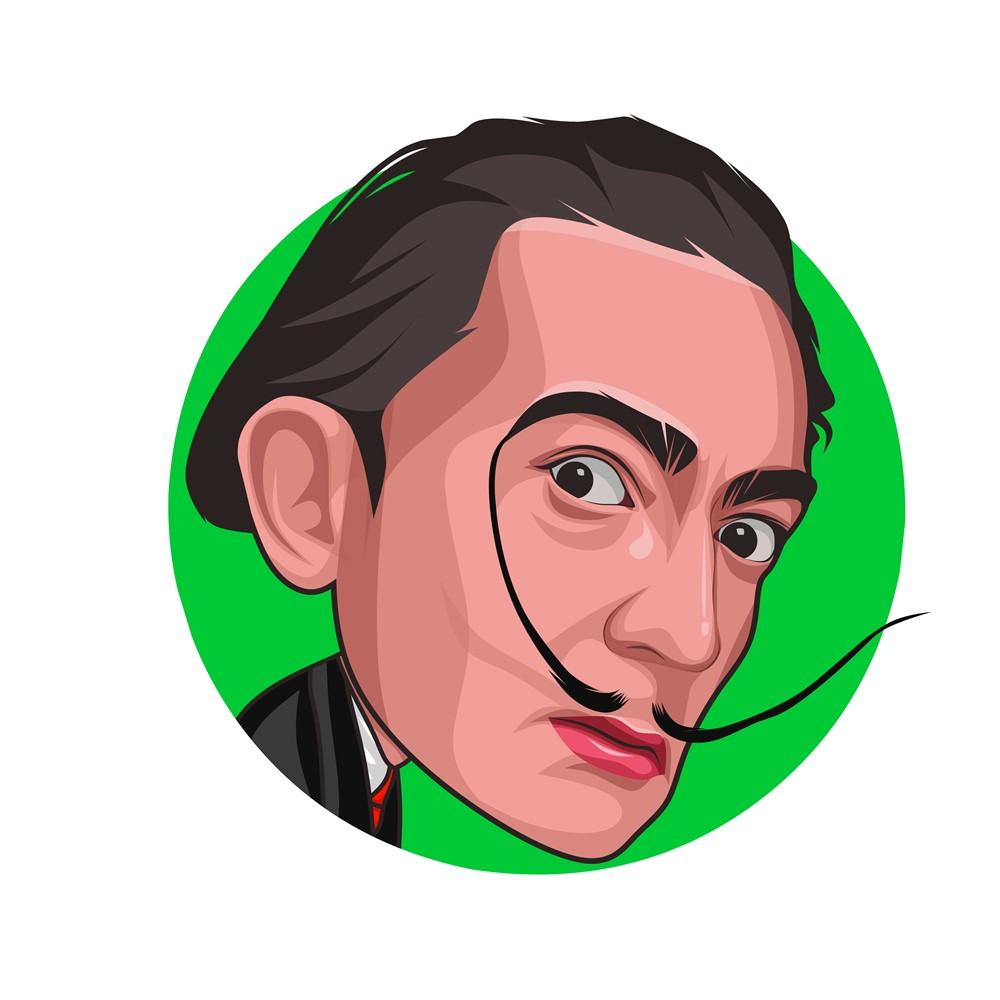
Known for his works in the Surrealist style, Salvador Dal is an artist who has inspired many to create their own works of art. He is also a subject of much controversy, with the exhumation of his body after being found unidentified, and his paintings being disputed as being real. Here is a brief look at his life and work.

Often referred to as the “King of Surrealism,” Salvador Dali is a Spanish artist who was widely regarded as a visionary filmmaker. His art leans on autobiographical content and includes ready-made symbolism.
The young Salvador Dali was born in a small town outside Barcelona in Spain. His father, Salvador Dali y Domenech, was a middle-class lawyer and notary. The family suffered a lot before the young boy was born. However, when he was only nine months old, his father died.
He was a very intelligent child, but his father did not tolerate his eccentricities. After a short period of time, he was expelled from school. It was during this period that he acquired an interest in art. He began experimenting with Cubism. Then he grew closer to Federico Garcia Lorca.
During this period, Dali met Elena Ivanorna Diakonova, known as Gala. They began an affair. Their relationship deteriorated when Gala became depressed. During this time, Dali found a private language. Eventually, they were married.
In 1941, the Metropolitan Museum of Modern Art held an exhibition of his work. He was also invited to participate in the Dada-Surrealism exhibition in New York.
After World War II, Salvador Dali and his wife moved back to Europe. They worked at Sant Ferran castle in Figueres, Spain. He was then appointed to the Zodiaque Group, which commissioned him to make works.
During the 1920s, Salvador Dali exhibited a lot of surrealist artwork. His paintings exemplified the surrealist preoccupation with dreams and mental states. Among his most well-known works is The Persistence of Memory (1931).
It shows a melting watch on a branch of a tree. It also illustrates the concept of hard and soft. The painting also distorts the boundary of space.
Salvador Dali’s work became very popular during the 1950s and 1960s, especially in the United States. His work was rooted in the great tradition of art and the artist’s personal imagination. His art is often viewed as an extension of his obsessions with psychosis, death and deterioration.
Aside from his visual arts, Salvador Dali was also a writer, photographer and sculptor. He also made two movies. The films are filled with grotesque but highly suggestive images.
In the mid-1930s, Salvador Dali visited the United States for the first time. Then he started studying the work of several artists. He recognized his obligation to Raphael, Rembrandt and Johannes Vermeer. He also became interested in the Renaissance and Cubist styles of art.
He began to use optical illusions, such as melted clocks and floating eyeballs. He later learned that he could create reality from his inner thoughts. During this period, he became fascinated with the power of modern science. He also wrote poetry and fiction.
Salvador Dali was an eccentric personality. He was not patient and was prone to outbursts. His family believed that he was the reincarnation of his deceased brother.
Among the best known Surrealist paintings is The Persistence of Memory, which depicts melting watches on rocks. The painting also includes ants, which symbolize a state of grotesque decay.
Salvador Dali’s most famous work, The Persistence of Memory, is a powerful image of the concepts of time and destructibility. He used a method of irrational knowledge, called the paranoiac-critical method, to produce his art. This method involves self-induced paranoia and a critical objectivity of associations.
Dali was one of the most influential Surrealists, a group of artists who rejected rationality in art. They aimed to reach the subconscious mind to unlock its power. Their works were often influenced by Freud’s theories on the subconscious.
In addition to his paintings, Dali also worked in sculpture and fashion. He also experimented with dream images in his art. He used praying mantis forms in many of his pieces.
He also made use of the “automatic writing” style, which is a type of free-writing. He was also an avid reader of Sigmund Freud’s psychoanalytic theories.
Dali was born in a small town outside Barcelona, Spain. His family suffered greatly during his childhood. His mother Felipa Domenech Ferres encouraged him to be eccentric. In 1929, he joined the Surrealist movement. However, he was expelled from the group in 1934. The reason for his expulsion is disputed by some art historians. Others believe it was because of his feud with Andre Breton, the leader of the group.
Amongst the many Salvador Dali paintings, “The Elephants” is one of the most striking works. It is the only painting with elephants as the focal point. At first glance, it is difficult to understand the significance of the painting.
The painting features two elephants on stilts standing in front of a sunset. A hut appears in the background, but is only a small detail. The painting is a surrealist work and based on dreams.
The Elephants is an oil painting on canvas. The elephants feature long elongated legs, but their trunks are angled upwards. They are covered with patterned carpets in shades of gray. The elephants also have an oil derrick-like top piece. There is also a puff of smoke near the back of the elephant.
The painting is not as big as some of the artist’s other depictions of elephants. It is only 32 inches tall. The image is more like a sky at night than a real elephant.
The obelisk is not a new idea. The Egyptians used the symbol in their pyramids and temples, but it was not widely adopted until the Renaissance. The elephant in “The Elephants” is the first to use the symbol in a modern context.
The Elephants is the most important art work of Salvador Dali. He used this painting to illustrate his view on the power of dreams and their impermanence.
Almost thirty years after Salvador Dali died in Figueres, Spain, his embalmed body is finally being reclaimed. His remains are being retrieved from a crypt beneath the Dali Theatre Museum in the northeastern town of Figueres.
The exhumation of Dali’s body will be conducted by the Gala-Salvador Dali Foundation, which manages Dali’s estate. The organization applied an embalming process to Dali’s remains 27 years ago. It is expected to seek financial compensation for the cost of the exhumation.
The exhumation is being undertaken as a result of a paternity claim by Pilar Abel, a Spanish woman who claims she is Dali’s daughter. She is a tarot card reader and has been attempting to prove her father is the famous painter for some time now.
Abel’s claim is not without merit. She worked as an employee of a family near the artist’s home in Cadaques. She claims she was told a family secret when she was young. She has attempted to prove her father is Dali through DNA tests. However, she claims she never received any of the results.
The exhumation of Dali’s corpse is being done in a very sensitive manner, requiring the removal of a 1.5 ton stone slab that provides access to the crypt with Dali’s tomb. A lawyer for Ms Martinez said the exhumation could take place as soon as July.
The exhumation of Dali’s remains is an attempt to obtain DNA for a paternity claim. This has prompted the Gala-Salvador Dali foundation to take legal action to nullify the test.
Throughout his life, Salvador Dali had many influences on his work. These varied from his artistic styles to his personality.
Salvador Dali was born in a small town near Barcelona. His family suffered greatly before his birth. In 1921, his mother died from breast cancer. His father married a sister of the deceased woman. He later moved to the city of Port Lligat where he would spend his adult life.
At age 15, Salvador Dali had his first art exhibit. He was dismissed from the academy after a student protest. His work soon started to include divine geometry, optical illusions, and DNA. His artwork also included a Hyper Cube.
After his mother’s death, Salvador Dali realized that he had no chance of leaving his mark on the world. He then became interested in the Futurist movement’s attempt to create motion. He was also drawn to sexual imagery. He viewed women as mysterious objects of power and seduction.
After his marriage, his sexual imagery became muted. He was also drawn to politics. His work contained images of Hitler and Lord Chamberlain of Britain. He also created a series of paintings about war and politics. He later created two Surrealistic films. His work also consisted of highly suggestive but grotesque imagery.
When he was 24 years old, Salvador Dali began to incorporate Surrealist concepts into his paintings. His first famous painting was The Persistence of Memory. This painting was a turning point in his relationship with the Surrealists.
Max Ernst Among the most famous artists of the twentieth century, Max Ernst was a
Angelina Jolie DCMG – An Icon in Hollywood Whether you love her as an actress
Barack Hussein Obama II Barack Hussein Obama II served as the 44th President of the
A Brief Look at Ben Affleck Benjamin Affleck is a well-known American actor and director.
Alicia Keys Alicia Keys is a famous American singer, songwriter and pianist. She was born